Peter IV king of Aragón (1336–1387). He was the seventh king of the Crown of Aragon, and father of Juan I (1387–1396) and Martín I (1396–1410), the last members of the dynasty to take the throne. When Martín died, the Trastámara branch occupied the throne of the kingdom. Peter IV was dazzling in his ability to use art as a tool of authority and sovereignty. With the aim of exalting the dynasty, he patronised various enterprises, among the most important of which was the abbey of Santa Maria de Poblet, which he intended to be a burial place for himself and his successors, a wish that was fulfilled, without exception, down to Juan II, the predecessor of the Catholic Monarchs. A perfectionist and zealot, he endowed important religious events with profound political significance, and promoted works of great symbolism such as the genealogy of the new saló del tinell, or the ordinacions de la casa i cort, to which he added an appendix establishing how the kings of Aragon were to be crowned.
- royal images
- royal iconography
- kings of Aragon
- Crown of Aragon
- Peter IV of Aragon
1. An Exceptional Reign
2. Cultural Personality: Profitability of Arts and Literature
3. Coronation Ceremony and Iconographic Echoes
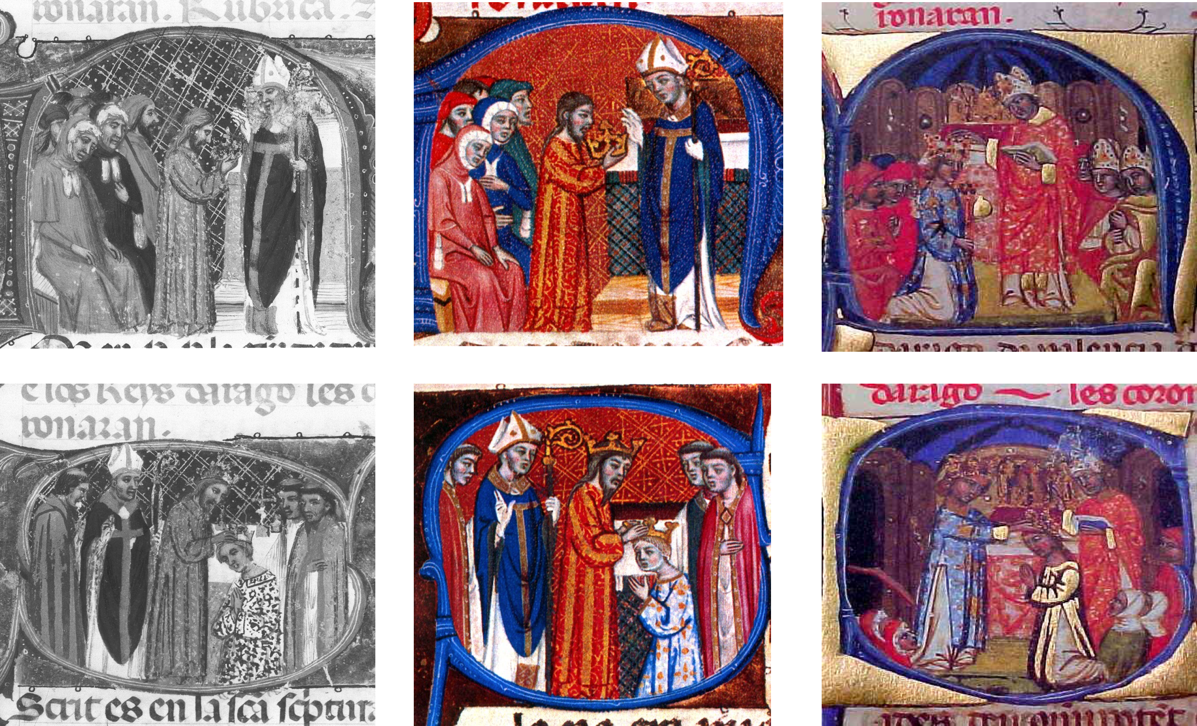
Figure 1. Ceremonial de consagración y coronación de los reyes y reinas de Aragón. Left: Ms. Esp. 99, Paris, Biblothèque Nationale de France ©; Center: Ms. Reg 14.425, Madrid, Fundación Lázaro Galdiano ©; Right: Ms. Phillips 2633, Palma de Mallorca, Fundación Bartolomé March ©. Images published in [18].
4. Conquest of Mallorca: Iconographic Echoes
4.1. Coinage

4.2. Sigillography
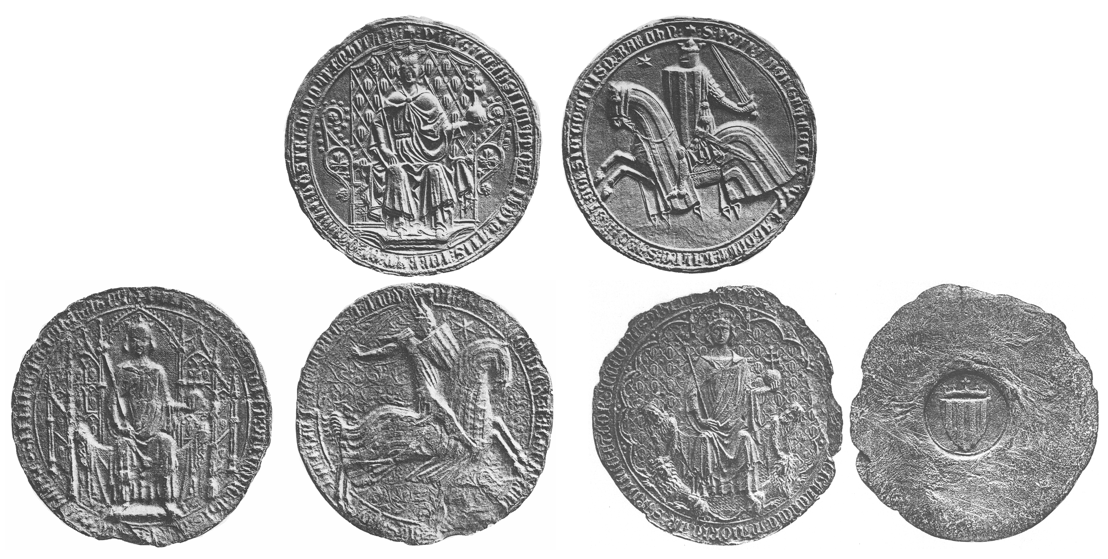
4.3. Court and Household Ordinances
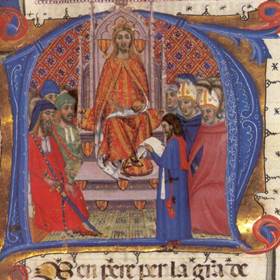
5. Artistic Commissions for the Glory of the Monarchy
5.1. Devotion and Profitability
5.1.1. Second Translation of the Relics of Saint Eulalia
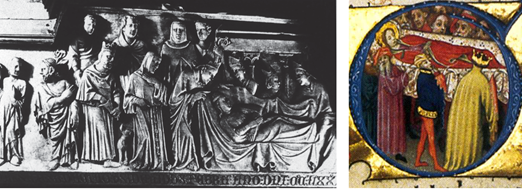
5.1.2. The Pantheon of Poblet
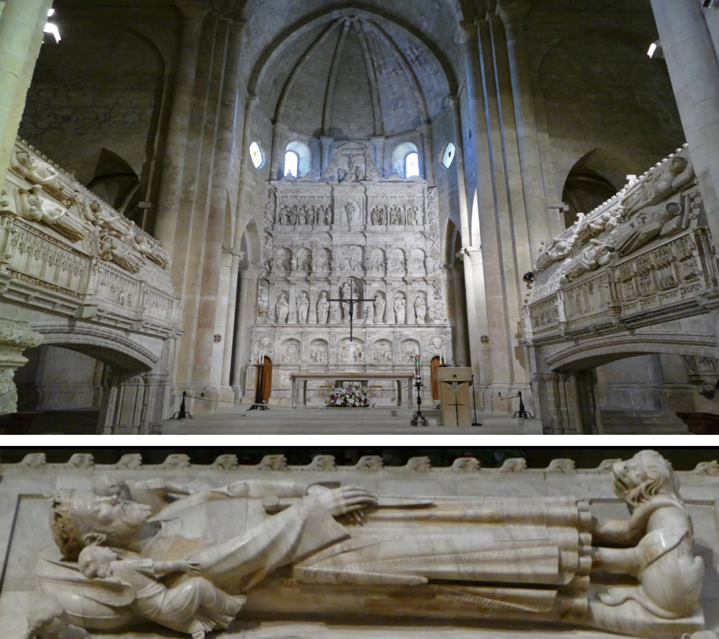
5.2. Other Royal Initiatives: Relevance of Genealogies
5.2.1. The Saló del Tinell
In 1359 he erected the cambra major, or saló del tinell, the first stone of which was laid after consulting his astrologers. Peter IV devised the allegorical stories to be painted on the walls, and the commemorative ones above the entrance door [44]. The room was complemented by a gallery of sculpted portraits of members of a political and legal system of the first order, thus legitimising and conferring an aura of glory on them while at the same time giving the room a sense of magnificence. The idea first came to him in 1342 and led him to contract the master Aloi (See [39]: 213–214) to carve 19 statues of kings of Aragon and counts of Barcelona to be attached to the diaphragmatic arches of the hall (See [41], p. 20), the location for of the most illustrious ceremonies. None of these have survived, but their commission is evidence of the monarchy’s new urge, under Peter IV, to glorify and perpetuate the dynasty. He wished to show the continuity of his institution by arranging the sculptures of his forebears in order and to inspire the moral rectitude of his successors, who would see in the symbolic hall the images of their exemplary predecessors (See [45], pp. 177–192]. Also [8]). It would also be evocative for his subjects, who would see the representation of dynastic power in an emblematic and performative room to which the most illustrious magnates of the kingdom had access.
5.2.2. The Coronation Sword
In 1360 Peter IV commissioned the Valencian silversmith Pere Bernés, “fidelis argentarium noster” (De Dalmases, N. Els argenters de la cort en temps de Pere III. In [4], p. 204), to make a sword with the “most beautiful, richest and most subtle” ornamentation possible. “But in particular we want the outside of the scabbard to feature 19 enamels from one side to the other done in such a way that each one can display the figure of a king or count. Because in these enamels we want to have the figures of the kings of Aragon and counts of Barcelona, past, and our own” [46]. To understand the meaning of this sword, it is essential to relate it to Peter’s aforementioned Coronation Ceremonial, which turned the coronation into a visual spectacle (See [45], p. 178). Given the importance of the ceremony, the elements used in it, including the insignia, had to be carefully selected. The promotion of the sword by Peter was probably greatly influenced by his conquest of Mallorca and has been noted by historiography. The king, understanding the ornamentation of this regalia as a visual resource and as a categorical mnemonic technique, adopted two important concepts to emphasise and recall the stability of the monarchy over time, namely, lineage and territorial expansion, both of which are identifiable in the iconography of the scabbard [47]. After his annexation of the kingdom of Mallorca, the genealogy represented on the scabbard had a legitimising effect on his conquest. The decoration proclaimed a continuous and uninterrupted dynastic succession, albeit a false one, in the different kingdoms over which the new monarch would rule once crowned. Peter IV was again able to compare himself to James I by linking the sword to the right of conquest, which was the basis of his power, and by handing the sword over to his heirs as an emblem that would play a similar role to that of Tisó (Tizona or Tizón in Spanish is a sword that tradition attributed to Rodrigo Diaz, known by the title of Campeador) in their investitures [48]. This is related to the fact that in the Middle Ages it was common practice to recreate the past within the present in order to legitimise contemporary political practices [49].
6. Conclusions
Throughout his long reign, Peter IV was very skilful in the use of art as a tool of authority and sovereignty. With the idea of dynastic exaltation, he promoted the abbey of Santa Maria de Poblet by establishing it as a burial place for himself and all of his successors without exception until the death of Juan II, predecessor of Fernando II the Catholic. Consistent with his project, he endowed the monastery with a royal library that would house historical books commemorating the illustrious dynasty to which he belonged, with walls to safeguard his famous ancestors, royal chambers where he could stay during his stays in the monastery, and a magnificent pantheon that he devised and altered as the works progressed. As a perfectionist, he deliberately sought out those who could provide the tombs with realism and accuracy, an attention to detail that can also be seen in other important undertakings such as the sculptural genealogy destined for the new hall of the Tinell or the ordinacions which are scattered throughout different libraries in beautifully illuminated codices. In a direct continuation of the practice established by his father Alphonse, Peter IV added to these ordinations an appendix in which he established the manner in which the kings of Aragon were to be crowned, specifying that, during the ceremony, all the insignia, including the crown, could only be handled by the king. This substantial peculiarity, visible to his subjects during the ceremonial, was also represented iconographically in the miniatures that decorate the folios of the ceremonial books except, perhaps tellingly, the Libro de coronación de los Reyes de Castilla y de Aragón. That Peter IV conceived art as a means of propaganda is also corroborated by the translation of the relics of Santa Eulalia, on whose sarcophagus the king and perhaps also Queen Elisenda are depicted in the Franciscan habit, an event for which he sought the most religiously and politically advantageous occasion. Above all, there is his conquest of Mallorca, an annexation which, although he considered justified, he legitimised through his iconography by copying without compunction the works of his bitter enemy, the ill-fated Mallorcan king when creating the aforementioned ordinacions and the seals and coins that he issued after his accession. It is in relation to this last event that another of his most symbolically important commissions must be attributed, namely, the scabbard of the coronation sword, which showed a genealogy featuring the figures of his predecessors. With this commission, he revived the sword as an insignia with much the same commitment as his much-admired predecessor, James I, whom he had evoked during the conquest of Mallorca and who, by appearing in the iconography of the enamelled royal lineage, also justified it.
References
- Pedro IV. Crònica. Les quatre grans cròniques, 3rd ed.; Soldevila, F., Ed.; Selecta: Barcelona, Spain, 1983; chap. 1 par. 40.
- De Zurita, J. Anales de Aragón; Institución Fernando el Católico: Zaragoza, Spain, 1998 (1562); lib. X, chap. XXXIX.
- Rubió, A. La Acrópolis de Atenas en la época catalana; Academia Provincial de Bellas Artes de Barcelona: Barcelona, Spain, 1908.
- Pere el Cerimoniós i la seva època. Anuario Estudios Medievales 1989, 24.
- Hillgarth, J.H. La personalitat política i cultural de Pere III a través de la seva crònica. Lengua & Literatura 1992–1993, 5, 7–102.
- Gimeno, F. Escribir, reinar: la experiencia gráfico-textual de Pedro IV el Ceremonioso (1336–1387); Abada: Madrid, Spain, 2006.
- Sesma, J.A. Pedro IV y la proyección de la imagen real en la Corona de Aragón. In La construcción medieval de la memoria regia; Martínez, P., Rodríguez, A., Eds.; Universitat de València: Valencia, Spain, 2011; pp. 123–415.
- Molina, J. La memoria visual de una dinastía. Pedro IV el Ceremonioso y la retórica de las imágenes en la Corona de Aragón (1336–1387). Anales Historia Arte 2013, 23, 219–241.
- Muntaner R. Crònica. Les Quatre Grans Cròniques, 3rd ed.; Soldevila, F., Ed.; Selecta: Barcelona, Spain, 1983; Chapter CCXCIV.
- Palacios, B. La coronación de los reyes de Aragón, 1204–1410: Aportación al estudio de las estructuras políticas medievales; Anubar: Valencia, Spain, 1975.
- Duran, A. El rito de la coronación del rey en Aragón. Argensola 1989, 103, 17–40.
- Serrano-Coll, M. De Modo Qualiter Reges Aragonum Coronabuntur. Visual, Material and Textual Evidences during the Middle Ages. Arts 2020, 9, 25.
- Aurell, J.; Serrano, M. The Self-coronation of Peter the Ceremonious (1336): Historical, Liturgical and Iconographical Representations. Speculum 2014, 89, 66–95.
- Gimeno, F.; Gonzalbo, D.; Trenchs, J. Ordinacions de la Casa i Cort de Pere el Cerimoniós; Fonts Històriques Valencianes: Valencia, Spain, 2009; annex: Ordinacions con los reys e reynas d’Aragó se consagren e·s coronen; II.1.
- Vicente de Vera, E. (coord.) (Ed.) Ceremonial de Consagración y Coronación de los Reyes de Aragón. Ms. R. 14.425 de la Biblioteca de la Fundación Lázaro Galdiano; Centro de Documentación Bibliográfica Aragonesa: Zaragoza, Spain, 1992.
- Palacios, B. El ‘Manuscrito de San Miguel de los Reyes’ de las ‘Ordinacions’ de Pedro IV; Facsimile Edition; Scriptorium: Valencia, Spain, 1994.
- Serrano-Coll, M. Effigies Regis Aragonum. La imagen figurativa del rey de Aragón en la Edad Media; Institución Fernando el Católico: Zaragoza, Spain, 2015; pp. 279–286.
- Serrano-Coll, M. El arte áulico mallorquín y su reflejo en los proyectos artísticos de Pedro IV el Ceremonioso. In Modelos, intercambios y recepción artística; Universitat de les Illes Balears: Palma de Mallorca, Spain, 2008; pp. 175–185.
- Mateu, F. Les relacions del Principat de Catalunya i els Regnes de València i Mallorca amb Anglaterra i el paral·lelisme monetari d’aquests països durant els segles XIII, XIV i XV; Societat Castellonenca de Cultura: Castellón, Spain, 1934; p. 77.
- Mateu, F. La moneda de los reinos de Valencia y Mallorca; Anubar: Valencia, Spain, 1977; pp. 143–144.
- De Sagarra, F. Apuntes para un estudio de los sellos del rey don Pedro IV de Aragón. Memorias Real Academia Buenas Letras Barcelona 1898, VI, 108.
- De Sagarra, F. Sigil·lografia catalana. Inventari, descripció i estudi dels segells de Catalunya; Estampa d’Henrich: Barcelona, Spain, 1916–1932; Volume I, p. 123.
- Dalas, M. Les sceaux royaux et princiers. Étude iconographique. In Chartes, Sceaux et Chancelleries. Études de Diplomatique et de Sigillographie Médiévales; Bautier, R.H., Ed.; Droz: Paris, France, 1990; Volume II, pp. 76–95.
- Menéndez Pidal de Navascués, F. The Anglo-French and Mediterranean typologies on the Iberian Peninsula were disseminated by Menéndez Pidal, F. In Apuntes de Sigilografía Española; Minaya: Guadalajara, Mexico, 1993; p. 105.
- Beauchamp, A. Ordonnances et réformes de l’hôtel royal au debut du règne de Pierre IV d’Aragon. Anuario Estudios Medievales 2009, 39, 555–573.
- Durliat, M. Jaume III Rei de Mallorca. Lleis Palatines; José J. de Olañeta: Palma, Spain, 1991; p. 17.
- Finke, H. Acta Aragonensia 1908, I, XXX–XLVII, 1911, I, XVI–XXV.
- Schena, O. Le Leggi Palatine di Pietro IV d’Aragona; Edizione della Torre Cagliari: Cagliari, Italia, 1983.
- Wittekind, S. Las Ordenacions de Pedro el Ceremonioso en París, adaptación, transposición y reorganización artística. In Art fugitiu: Estudis d’art Medieval Desplaçat; Alcoy, R., Ed.; Universitat de Barcelona: Barcelona, Spain, 2021; pp. 317–337.
- Montaner, A. El Señal del Rey de Aragón: Historia y Significado; Institución Fernando el Católico: Zaragoza, Spain, 1995; p. 67.
- Yarza, J.; Marcon, S.; Arnall, M.J. María de Navarra y la ilustración del Libro de Horas de la Biblioteca Nazionale Marciana. In Libro de Horas de la reina María de Navarra; Moleiro: Barcelona, Spain, 1996.
- Letter from the Archivo Histórico de la Ciudad, Barcelona (Fons Notarial Serie C, XIX, 4). Unpublished work. 1339.
- Mas, J. Nota histórica. La Cripta de Santa Eularia a la Séu de Barcelona; Tipografia Catòlica: Barcelona, Spain, 1914; p. 14.
- Bracons, J. Una revisió al sepulcre de Santa Eulàlia. Quaderns d’Arqueologia Història Ciutat 1980, XVIII, 119–140.
- Español, F. Cultos cívicos y su epicentro en los territorios del oriente peninsular: el sepulcro de Santa Eulalia de Barcelona. In La Cattedrale Nella Città Medieval: I Rituali; Lucherini, V., Boto, G., Eds.; Viella: Roma, Italy, 2020; pp. 311–329.
- Franco, A. Relaciones hispano-italianas de la escultura funeraria del siglo XV. In La Idea y el Sentimiento de la Muerte en la Historia y en el Arte de la Edad Media; Núñez, M., Portela, E., Eds.; Universidad de Santiago: Santiago de Compostela, Spain, 1986; p. 110.
- Soler, A. Sarcòfag de Santa Eulàlia a la Catedral de Barcelona. Arquitectura i Urbanisme 1934, 3, 12.
- Arxiu de la Catedral, cod 116. Study of this manuscript in Planas, J. El Misal de Santa Eulalia. Boletín del Museo e Instituto Camón Aznar 1984, XVI, 33–62.
- Biblioteca de la Universitat de Barcelona, ms. 1; and Monastery of Santa Maria de Poblet, without sign., respectively. Unpublished work, C. 1409.
- Del Arco, R. Sepulcros de la Casa Real de Aragón; Instituto Jerónimo Zurita: Madrid, Spain, 1945; pp. 58–59, 288–289.
- Español, F. Els Escenaris del Rei: Art i Monarquia a la Corona d’Aragó; Angle: Manresa, Spain, 2001; pp. 167–996.
- Serrano-Coll, M. Rex et Sacerdos. A veiled ideal of Kingship? Representing priestly kings in Medieval Iberia. In Political Theology in Medieval and Early Modern Europe. Discourses, Rites and Representations; Herrero, M., Aurell, H., Micheli, A.C., Eds.; Brepols: Turnhout, Belgium, 2017; pp. 337–362.
- About parliaments: Cawsey, S. Kingship and Propaganda: Royal Eloquence and the Crown of Aragon c. 1200–1450; Oxford University Press: Oxford, UK, 2002.
- Duran, A. Barcelona i la Seva Història; Curial: Barcelona, Spain, 1975; p. 23.
- Verrié, F.P. La política artística de Pere el Cerimoniós. Anuario Estudios Medievales 1989, 24, 181.
- Rubió, A. Documents per a la Història de la Cultura Catalana Mig-Eval; doc CXCIII; Institut d’Estudis Catalans: Barcelona, Spain, 2000; Volume I, pp. 191–192.
- For both concepts and their use by Pedro IV: Sesma, A. La monarquía aragonesa. In Monarquía, Crónicas, Archivos y Cancillerías en los Reinos Hispano-Cristianos, Siglos XIII–XIV; Institución Fernando el Católico: Zaragoza, Spain, 2014; pp. 69–76.
- Serrano, M. Art to seal memory. Coronation ceremonies and the sword as symbol of power: Aragon 1200–1400. In Memory in the Middle Ages: Approaches from Southwestern Europe; Sabaté, F., Ed.; ARC: Leeds, AL, USA, 2020; pp. 242–246.
- Aurell, J. Els discursos del poder: la funció política de la historiografia. In L’Edat Mitjana: Món Real i Espai Imaginat; Sabaté, F., Ed.; Afers: Barcelona, Spain, 2012; p. 139.
